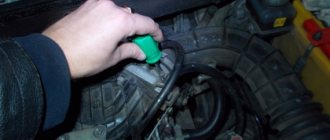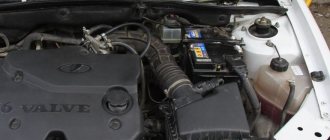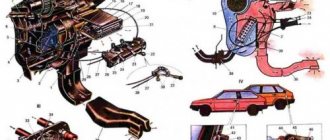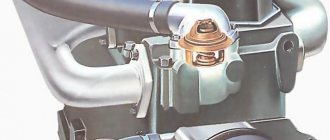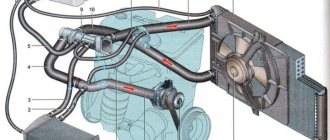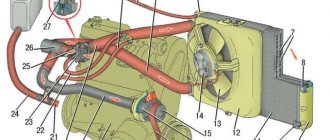The presence of air in the car's cooling system causes problems with engine overheating and ineffective operation of the interior heater. This article will present 4 methods by which it will become clear how to expel air from the cooling system of a VAZ 2114. The methods for solving the problem described in this article can be used on the entire family of first and second Samaras.
Useful video:
Signs of airing
The problem of air getting into the cooling system does not appear unnoticed. An increase in engine temperature, poor performance of the stove, and the presence of antifreeze leaks are clear signs of an airy system. Signs of an air lock in the VAZ 2114 cooling system:
- Engine overheating due to uneven cooling;
- Dips when pressing the gas pedal;
- No heating from the stove.
Violation of the temperature regime of the engine leads to its accelerated wear. Breaking the cylinder block gasket and getting antifreeze into the oil is not the worst scenario for such a malfunction. Engine wedge and the appearance of cracks in the cylinder block often occur precisely because of overheating, so you should carefully monitor the readings of the temperature sensor on the dashboard.
There are several reasons for problems with airing:
- A non-working thermostat jams, causing the temperature of the antifreeze to rise and it gradually evaporates;
- Leaking pipes;
- A breakdown in the cylinder block gasket leads to leakage of antifreeze into the cylinders (white steam from the exhaust pipe and the presence of an emulsion instead of oil is a sign of a broken gasket);
- Defective pressure relief cap on the expansion tank.
In any case, the problem with the air lock must be corrected promptly. Methods to expel air from the VAZ 2114 cooling system are described below.
Helpful : What to do if the heater blows cold air onto the windshield?
Why is the cooling system malfunctioning?
The main malfunction of the cooling system occurs as a result of incorrect operation of the thermostat. In a particular case, the only solution will be to replace it.
Before you begin work on replacing the thermostat valve, it must be checked for serviceability by starting the engine while it is cool. When the engine warms up to about 90 degrees, touch the pipe at the bottom of the radiator, it should be warm, this indicates the serviceability of the valve; if the pipe is cold, the valve must be replaced.
VAZ 2114 car models have an aluminum radiator; it is equipped with two additional tanks; the left one has a partition.
The cooling system is quite simple, so you can carry out repairs yourself. The radiator is the main component of the car’s cooling system, its main function is to prevent engine overheating by removing warm air from the engine to the outside.
- The radiator itself.
- Bottom tank with pipes.
- Top tank with pipes.
Method 1
When starting to consider ways to remove an air lock from the cooling system of a VAZ 2114, the first step is to consider the easiest option. This method is based on physics. Because air in a liquid always tends to the top, you can put the front of the car on a hill, then unscrew the cap of the expansion tank and wait for the air to come out. Also, when lifting the car, you need to warm up the engine.
Adding gas will speed up the process of air leaving the system. Also, in the process of removing the plug, you need to switch the stove to the hottest mode and turn on the first fan speed. This method does not always help, because... it all depends on the location of the plug in the circuit. If there are leaks from the pipes or from under the thermostat, this method will only give a temporary effect, because the circuit will become leaky and will take in air again. Since it is not always possible to remove an air lock from the cooling system the first time, you can use other methods.
Disadvantages in the cooling system
The VAZ 2114 engine cooling system has a big drawback, because... requires constant monitoring, frequent maintenance and necessary repairs.
VAZ 2114 cooling system diagram
Cooling diagram for VAZ 2114 : 1 – element in the form of a plug for the expansion tank; 2 – expansion tank; 3 – hose for draining liquid from the pipe; 4 – hose passing between the radiator and the expansion tank; 5 – hose leading from the radiator; 6 – tank to the left of the radiator; 7 – aluminum tube; 8 – plug systems; 9 – tank to the right of the radiator; 10 – drain plug; 11 – middle of the radiator; 12 – casing for electric fan; 13 – plastic wings of the electric fan; 14 – electric motor; 15 – toothed pump pulley; 16 – pump impeller; 17 – camshaft drive belt; 18 – engine block; 19 – pump pipe; 20 – radiator hose with supply function; 21 – heater radiator hose with drain function; 22 – hose supplying coolant to the throttle pipe; 23 – exhaust pipe; 24 – hose for refilling; 25 – heater radiator hose with supply function; 26 – thermostat; 27 – coolant temperature sensor; 28 – coolant level indicator sensor.
Method 2
A more sophisticated and effective way to get rid of a traffic jam is to create pressure in the system by the owner of the car himself. Briefly, the essence of the method is the following steps:
- Unscrew the engine oil filler cap;
- Remove the rubber gasket from it and return the cover to its place;
- Next, unscrew the cap from the expansion tank;
- Release one of the tubes leading to the throttle from the clamp and remove it from the metal pipe;
- Cover the neck of the tank with your mouth and blow into it, creating pressure in the circuit;
- After the antifreeze begins to flow out of the pipe without bubbles, put it in place and tighten it with a clamp;
- Reassemble the removed parts in reverse order.
This method may seem unsafe, because... There is a risk of inhaling antifreeze vapors when blowing air, but at low temperatures this procedure is safe. If the cooling system is still not free of the plug, use the following method.
Thermostat problems
When the temperature reaches 95 degrees Celsius, the liquid begins to flow through the thermostat. Due to the operation of this unit, the engine requires a minimum of time and resources to warm up. The thermostat is located between the radiator and the engine.
Most often there are two types of faults.
- The valve closes. If the engine is not warmed up, it is difficult to maintain speed. It may simply stall.
- The valve opens. During frosty periods, you can operate the car, but you must turn on the heating at maximum speed. Otherwise, the power unit will simply overheat.
If you are unable to move the valve while repairing the thermostat, don't be afraid to lightly tap the housing with a simple screwdriver. This will solve a common problem.
When the thermostat is completely disassembled, the pipes are hermetically sealed, which will prevent coolant leakage. Only after this can you start working.
In general, the choice between antifreeze and antifreeze should not be a problem for you. Choose antifreeze. Although it is more expensive, it lasts longer and allows you to minimize possible problems with wear and tear of the cooling system. The imaginary savings due to antifreeze are not called that for nothing. In the future, you will pay much more to fix the damage caused by the use of antifreeze.
Method 3
The troubleshooting algorithm looks like this:
- Warm up the engine to operating temperature without allowing the cooling fan to operate;
- Similar to the second method, remove one of the pipes from the throttle;
- When you remove one of the tubes, air will come out, after which antifreeze will begin to flow out. At the same moment, place the tube in place and tighten the clamp.
Understanding how to remove air from the cooling system on a VAZ 2114 allows you to eliminate the problem of sudden engine overheating due to a traffic jam anywhere. It is enough to have a screwdriver to unscrew the pipes from the throttle and work on eliminating air can begin.
Changing the coolant strictly according to the maintenance regulations
It is important to change the coolant frequently to prevent engine damage, because Over time, it loses its properties and is subject to heating.
To carry out work on changing antifreeze or antifreeze, you need to know the important components:
- Know the period during which you can use cooling liquid, antifreeze for 2 years, antifreeze for 5 years.
- Monitor the mileage for fluid changes, usually from 20,000 to 40,000.
- Check the condition of the fluid, paying attention to the color; if the color has changed after use, the fluid must be replaced.
Method 4
The most effective, but labor-intensive method to fix the problem is described below. The only thing additionally required is a container of antifreeze.
- First, warm up the engine to operating temperature;
- Raise the front of the car so that the radiator cap is the highest point;
- Remove one of the pipes from the throttle and dip it in a container with antifreeze;
- Then, simultaneously with adding gas, add antifreeze to the tank;
- As soon as the bubbles in the container disappear, you can put the pipe back in place.
You need to understand that an air lock in the cooling system over time can cause sudden overheating of the engine and complete failure of the stove. You can ventilate the circuit yourself using the methods described above, but you should regularly check all connections and the tank for leaks. If even after removing the plug the engine continues to heat up, check the condition of the thermostat. Also, to prevent leaks, change the clamps on the pipes. Their rare use leads to relaxation of the pipes to the radiator, expansion tank and thermostat. For reliability, you can use joint sealant on the last element.
FEATURES OF ENGINE COOLING VAZ 2114
This car, like the VAZ 2113 and VAZ 2115, uses a VAZ closed liquid cooling system, the coolant in which is antifreeze or antifreeze. The coolant circulates through special channels in a running engine. Its circulation is ensured by a pump, which is driven by the engine crankshaft using a drive belt.
It regulates the flow of coolant, its direction, by a device called a thermostat. It is designed in such a way that before the coolant warms up to operating temperature, it circulates in a small circle, bypassing the radiator. When the liquid reaches a temperature of 870C, it opens and the liquid flow is directed to the radiator for cooling.
The radiator is blown by a flow of oncoming air, and when there is not enough air, an electric fan turns on. For these purposes, a sensor is installed in the radiator, which produces a signal to turn it on. Also, hot liquid flows through the heater radiator and heats the interior of the car in cold weather. Excess antifreeze from thermal expansion is collected in an additional tank, which is called an expansion tank.
Radiator repair
In some cases, the radiator can be repaired, so you don’t have to buy a new spare part.
Mostly repair work consists of eliminating leaks that have arisen as a result of defects, cracks and holes.
Most often, liquid leaks at the junction of plastic and metal parts. If there is a small leak, you can pour a special liquid with a coolant mixture inside the radiator. Thanks to its special composition, this product will seal the defects that caused the leak. If the damage is serious, repairs will no longer save the situation; you will still have to replace the radiator.
Article on the topic: Replacing stabilizer struts on a VAZ 2110 (reasons and complete replacement process)
To check the tightness of the radiator, you can conduct a simple experiment at home.
- Fill the bathroom with enough water to submerge the radiator.
- Close all pipe openings tightly.
- Lower the radiator under water about 30-50 centimeters. Apply a pressure of 0.2 MPa to it.
- Watch what happens. If bubbles appear, the system is not sealed and needs to be repaired or replaced.
Do not even try to repair the radiator after side or frontal impacts in an accident. In such situations, he suffers first of all, and no clogging liquids will help you.
Why is an air lock dangerous?
An air lock is an accumulation of air inside the channels of the cooling system, which impairs the circulation of coolant. It acts as a gap in the flow that antifreeze cannot overcome. The consequences of an air lock are serious:
- uneven heat removal from the components and mechanisms of the power plant;
- motor overheating;
- incorrect display of information from engine sensors;
- thermostat damage;
- the interior heating system stops working.
Dangerous consequences include uneven heat dissipation and overheating. Due to the temperature difference in the nodes, uneven expansion of the metal occurs, which causes warping of the composite mechanisms. And overheating of the motor leads to a violation of the geometry of the block head.


